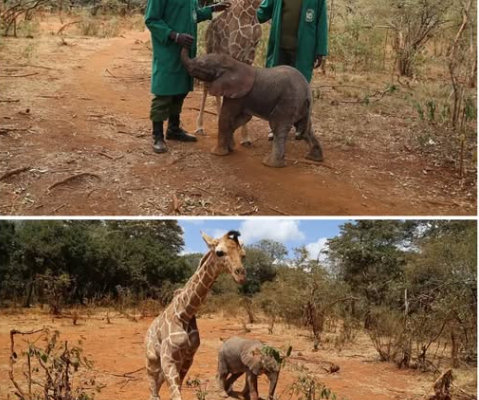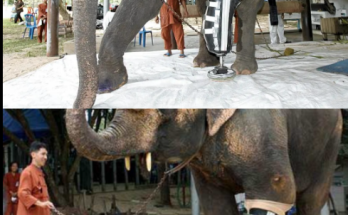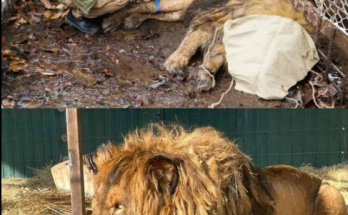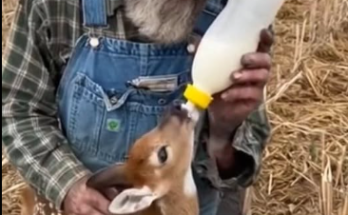In the heart of Nairobi, Kenya, a story unfolded that defies conventional understanding of the animal kingdom. It is a tale of companionship, resilience, and the power of empathy across species—a young giraffe named Kiko and an orphaned elephant calf named Loboito forging a friendship that would captivate the hearts of all who witnessed it.

Kiko, a one-month-old giraffe, had been found alone and vulnerable in Meru National Park, abandoned and unable to survive without maternal care. The Kenya Wildlife Service quickly intervened, transporting the fragile animal to a wildlife rehabilitation center designed to nurture orphaned and injured wildlife. The staff worked tirelessly to ensure that Kiko received the nourishment, warmth, and protection it needed to survive. Every feeding, every gentle touch, was a lifeline for the tiny giraffe who had faced such uncertainty at the outset of life.
Meanwhile, Loboito, a three-week-old elephant calf, had been rescued after being found alone and struggling in the wild. Like Kiko, Loboito was at a critical juncture in life—completely dependent on milk, guidance, and protection. Both young animals shared a precarious beginning, with the absence of their mothers leaving them exposed to the perils of the wild. Yet, fate would intertwine their paths in the most extraordinary way.

Because Kiko was too small to sleep safely in the designated giraffe enclosure, the caretakers placed him near Loboito and other young elephants. At first, the juxtaposition seemed unusual: a long-necked, spindly-legged giraffe lying beside a round, robust elephant calf. Yet, from the very first moment, a connection sparked between the two. Loboito, despite the disparity in size and species, approached Kiko with the gentle curiosity of a fellow orphan, its trunk extended as if to welcome the newcomer into its own fragile world.
The initial interactions were tentative. Kiko, wary of the unfamiliar presence, inched closer, observing the large, gray body and playful eyes of Loboito. The elephant calf, in turn, responded with a mixture of curiosity and enthusiasm, nudging and exploring, eager to establish a bond. In the sheltered environment of the orphanage, where danger was absent but survival instincts remained intact, a profound friendship began to take root.
As the days passed, their connection deepened. Video footage captured Kiko walking beside Loboito, attempting to match the elephant’s movements with its long, graceful legs. Loboito, though smaller in age than Kiko, was stronger and more boisterous, and yet the calf exhibited a protective and gentle nature. Observers marveled at the mutual understanding developing between these two seemingly incongruous companions. Loboito would lie beneath Kiko’s long legs, seeking the comfort of shade and warmth, while Kiko leaned down to nuzzle or groom the elephant calf, offering reassurance and companionship.
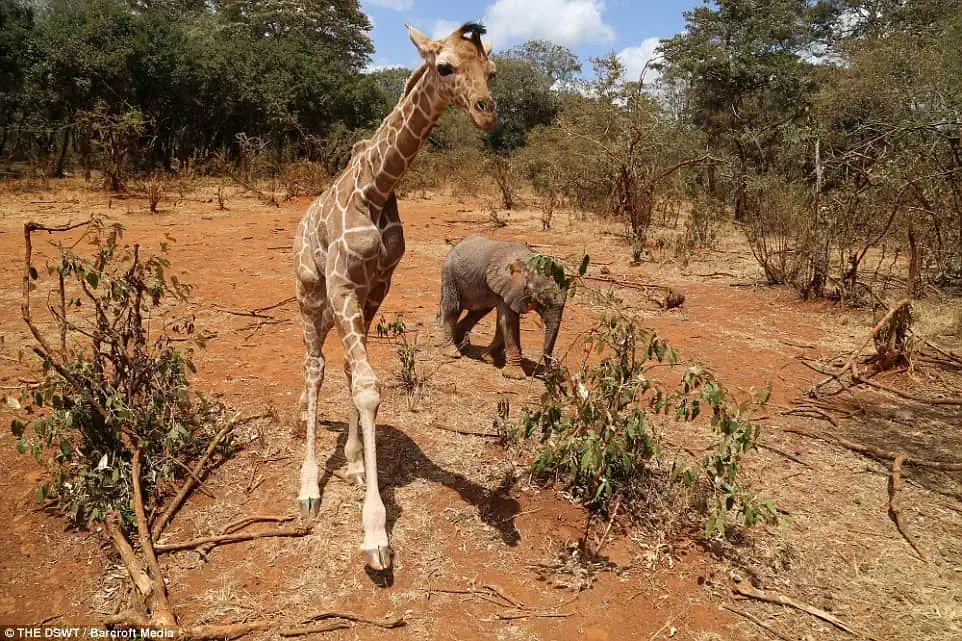
The caretakers at the David Sheldrick Wildlife Trust emphasized the significance of this bond. “Kiko has shown extraordinary trust and affection toward Loboito and our young elephants,” said Rob Brandford, CEO of the Trust. “From the moment he arrived, he sought the company of the smallest elephants, and Loboito followed him wherever he went. Their connection is remarkable—something we rarely see across species at this age.”
This extraordinary friendship was more than just heartwarming—it was critical for the emotional well-being of both animals. Being orphaned in the wild is a profound trauma, and young mammals rely heavily on social interaction for learning, security, and development. Through each other’s presence, Kiko and Loboito found not only companionship but also a sense of safety. They played together, slept in close proximity, and developed routines that mirrored those they would have experienced in the care of their mothers.
One of the most memorable moments captured on film showed Loboito following Kiko through the compound, trying to keep pace with the long-legged giraffe, tripping occasionally but determined not to be left behind. Kiko, aware of his smaller companion’s efforts, would pause, tilt his head, and gently touch Loboito with his nose. These interactions became daily rituals, a testament to the power of empathy and the ability of animals to form bonds that transcend species boundaries.

The caretakers’ devotion to the young animals mirrored the extraordinary connection between Kiko and Loboito. Volunteers fed them round-the-clock, offered comfort when they were distressed, and provided play and enrichment to mimic the challenges and stimuli of the wild. For Kiko, this meant climbing structures, exploring safe spaces, and learning to navigate his towering frame. For Loboito, it involved exercises to strengthen his legs, coordination games, and social interactions that would prepare him for eventual reintegration with wild elephants.
Despite the playful and joyful moments, the reality of their situation remained sobering. Neither animal would have survived in the wild without human intervention, as both were still reliant on milk for nutrition and were vulnerable to predators and environmental hazards. Yet, within the sanctuary, they flourished, demonstrating resilience, adaptability, and the profound effects of companionship.

Visitors to the wildlife trust were often enchanted by the pair. Footage showed Kiko lying down with his long legs curled around Loboito, the elephant calf resting beneath him. Volunteers marveled at their synchronization during feeding times, their coordinated play, and the sheer delight evident in their expressions. The interactions became a symbol of hope, illustrating how care, protection, and empathy can overcome the most challenging beginnings.
One of the most touching aspects of their friendship was the mutual respect they displayed. Kiko, despite towering above Loboito, never imposed, and Loboito, though boisterous, remained gentle and attentive. Observers described their relationship as almost human in its understanding—an intuitive bond that offered reassurance, comfort, and shared joy. They were, in every sense, each other’s family.
The caretakers also emphasized the educational value of such relationships. “Witnessing these interactions teaches us about the flexibility of animal behavior, the capacity for empathy, and the importance of social bonds,” said Brandford. “It reminds us that orphaned animals need more than nutrition—they need social interaction, love, and the ability to form attachments.”

Over time, Kiko grew rapidly, his long legs extending with remarkable speed, while Loboito gained strength and coordination. Despite the differences in size and species, their friendship remained constant. When Kiko explored new areas of the sanctuary, Loboito was never far behind. When Loboito practiced his walking and trunk coordination exercises, Kiko offered a calming presence, sometimes lying nearby, observing, and providing comfort. Their bond, forged in vulnerability and nurtured in safety, became inseparable.
The story of Kiko and Loboito has since become an emblem of hope for wildlife conservation. It highlights the essential work of organizations like the David Sheldrick Wildlife Trust in rescuing, rehabilitating, and preparing orphaned animals for eventual reintegration into the wild. Their friendship serves as a reminder that care and compassion can have profound impacts, not only on individual animals but also on broader public awareness and engagement with conservation efforts.

Public interest in their story soared. Videos of Kiko and Loboito playing, nuzzling, and resting together were shared widely on social media, inspiring viewers around the world. Comments ranged from awe at their unusual friendship to admiration for the dedication of the caretakers who made such interactions possible. For many, the pair became symbols of resilience, showing that even after tragedy, life can thrive with support and companionship.
The sanctuary staff also prepared for the eventual challenge of reintegrating the animals into their natural habitats. While Kiko’s unique physiology as a giraffe would eventually require release into a larger, open reserve suitable for his species, Loboito would join a protected herd of elephants in a safe, controlled environment. Plans were made to ensure that, even if they were separated for their respective futures, the pair would have the skills, confidence, and resilience to survive and thrive independently.
Despite this eventual separation, the impact of their friendship remained indelible. Observers note that their early experiences together taught both Kiko and Loboito essential social skills, reinforced trust in other beings, and provided the emotional foundation necessary to face the challenges ahead. The early bond acted as a buffer against trauma, allowing them to approach life with curiosity, courage, and confidence.
The tale of Kiko and Loboito is more than a simple story of two orphaned animals—it is a reflection on empathy, adaptability, and the transformative power of connection. It illustrates that even in the animal kingdom, relationships are essential for survival, growth, and emotional well-being. Their friendship transcends species, highlighting the universality of care, trust, and companionship.

In many ways, Kiko and Loboito teach us about resilience in the face of adversity. Both were thrust into a world without their mothers, facing the harsh realities of infancy and vulnerability. Yet, through the intervention of compassionate humans and the creation of a surrogate family unit, they not only survived but thrived. Their shared experiences—from the first tentative touch of trunks and noses to the joyful play sessions—serve as a model of adaptation, empathy, and the healing potential of social bonds.
Even as Kiko continues to grow into his long-legged, elegant frame, and Loboito develops into a strong, confident young elephant, the story of their friendship will endure. It will be recounted by the sanctuary staff, shared with visitors, and spread across the globe through videos and social media. Their bond exemplifies the unexpected joy and connection that can emerge from rescue and rehabilitation efforts, reminding us that care, love, and companionship can reshape the course of life, even for the most vulnerable.

For those who witness or hear the story, the takeaway is profound: life is fragile, but relationships—formed through trust, kindness, and support—can provide the strength needed to overcome adversity. Kiko and Loboito are living proof that friendship knows no bounds, that compassion can heal, and that even in the face of abandonment, survival and joy are possible.
In the quiet moments of the sanctuary, as the sun sets over the rolling savannah and the giraffe and elephant calves rest side by side, one can sense a deeper narrative unfolding. It is the story of two lives intertwined by circumstance and nurtured by care, demonstrating that even in a world often harsh and unpredictable, connection is the lifeline that makes survival, growth, and happiness possible.
💛 Kiko and Loboito’s friendship is a testament to hope, resilience, and the extraordinary bonds that can form between species. Their journey reminds us that love and compassion are universal, and that even the most unlikely companions can provide courage, comfort, and joy to each other in a world that often tests the limits of survival.
